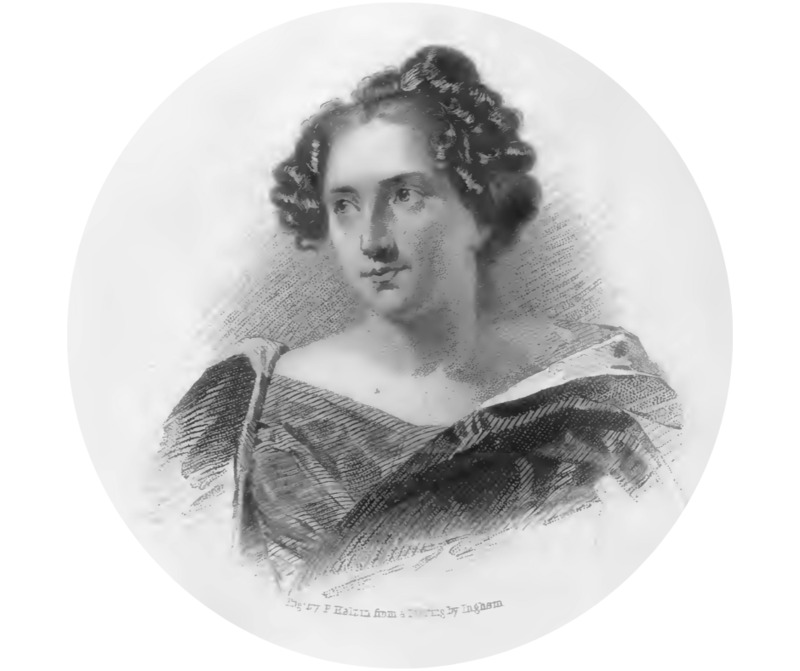Dublin Core
Description
Born in Stockbridge, MA, Catharine Maria Sedgwick was the sixth of the seven surviving children of Theodore Sedgwick and Pamela Dwight Sedgwick. Catharine’s mother was ill for most of her childhood and died when Catharine was seventeen. A year later, her father remarried Penelope Russell. For most of Catharine’s childhood, her father was away from home for more than half of each year pursuing a political career with six terms in the Continental Congress, U.S. House of Representatives, Speaker of the House, Senator from Massachusetts, and a Massachusetts Supreme Court Justice, and then passed away in 1813 when Catharine was twenty-three.
Although Catharine did not go to college, she considered herself to have been raised in a highly intellectual home:
"I was reared in an atmosphere of high intelligence. My father had uncommon mental vigor. So had my brothers. Their daily habits, and pursuits, and pleasures were intellectual, and I naturally imbibed from them a kindred taste" (Life and Letters of Catharine M. Sedgwick: 46-47).
When she was ten, Catharine could be found during her school lunch hour under her desk munching and reading Rollins’s Ancient History. While her four brothers followed in their father’s footsteps and became lawyers, they encouraged Catharine to pursue her writing, and she published her first book at age thirty-three.
Professionally, Catharine went on to become a successful and prolific author on a wide variety of topics in six novels, over one-hundred short stories and sketches, as well as domestic novellas, advice manuals, biographies, religious tracts, travelogues, and children’s books. She is considered to be one of the founders of American literature and enjoyed national and international renown during her lifetime. It is noteworthy that Catharine and Martha Washington were the only women selected for inclusion in the first volume of the National Portrait Gallery of Distinguished Americans.
The indefatigable Catharine continued to write for forty years publishing her last piece at the age of seventy-two. Catharine also taught at her sister-in-law’s Young Ladies’ School in Lenox, MA and various Sunday schools, including the Isaac T. Hopper Home. In her later years, she volunteered for the Female Department of the New York Prison Association (becoming president from 1848 to 1863), which led to her opening the Home for Discharged Female Convicts.
Personally, Catharine chose to become a member of her siblings’ households instead of marrying various suitors. For most of her life, she lived and worked in New York City and Stockbridge/Lenox, MA and traveled throughout North America and Europe. She also participated in the Berkshire’s literary society and received visits from authors, politicians, activists, and renowned international figures.
Catharine passed away in 1867 at the home of her niece in West Roxbury at the age of seventy-seven. She was remembered as a “true and beautiful soul, a clear and refined intellect, and a singularly sympathetic social nature” (Life and Letters of Catharine M. Sedgwick: 10) with “clear good sense, and graced by a charm of style of which she was the master during her whole life”:
"Her unerring sense of rectitude, her love of truth, her ready sympathy, her active and cheerful beneficence, her winning and gracious manners, the perfection of high breeding, make up a character, the idea of which, as it rests on my mind, I would not exchange for any thing in her own interesting works of fiction" (Life and Letters of Catharine M. Sedgwick: 446).
Catharine was buried in the family plot in Stockbridge next to her beloved nurse, Elizabeth (“Mum-Bett”) Freeman. (Massachusetts Historical Society Collections Online: Witness to America’s Past Description; Sedgwick Pie). Mum-Bett had been the first freed slave in Massachusetts who thereafter earned a living by working in the home of her attorney, Catharine’s father, and became an important mother figure to the family before her father remarried in 1808 (Massachusetts Historical Society Collections Online: Witness to America’s Past Description; Lucinda L. Damon-Bach & Victoria Clements, Catharine Maria Sedgwick: Critical Perspectives at xxiii and xxxiv (2003)).
Catharine had used her gift with words to memorialized Mum-Bett’s noble life in her article “Slavery in New England” in 1853 (Miss Sedgewick [sic], “Slavery in New England,” in XXXIV Bentley’s Miscellany at 417, 424 (1853)). Five years after Catharine’s death, Harper & Brothers would do the same for Catharine by publishing a book entitled the Life and Letters of Catharine M. Sedgwick, which was edited by her life-long neighbor, Mary E. Dewey.
Coverage
Person Item Type Metadata
Page(s) in WOC
Name in WOC
Birth Name
Gender
Religion
Birth Date
Birth Year
Generation
Birthplace
State or Country of Birth
Nationality
Lived or Visited Abroad
Education
Marital Status
Occupation(s) in WOC
Educational Institution
Conventions
Lectures
Places Resided
Location (Address, City/Town, State [if USA] or Country)
Personal Network
Death Date
URL
Notes
- A Woman of the Century incorrectly spelled Catharine's name as Catherine.
- Note that Catharine’s published paper spelled her nickname “Mum-Bett” not Mumbet or Mumbett, but the name on her headstone is spelled “Mumbet.” (See Miss Sedgewick [sic], “Slavery in New England,” in XXXIV Bentley’s Miscellany 417, 424 (1853)).
Item Relations
| Item: SIGOURNEY, Mrs. Lydia Huntley | knows | This Item |
| Item: CHILD, Mrs. Lydia Maria | knows | This Item |

